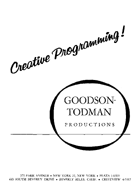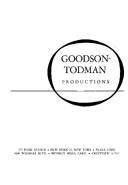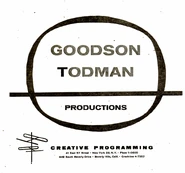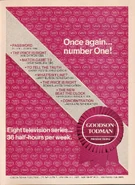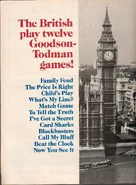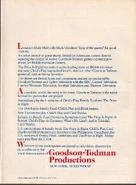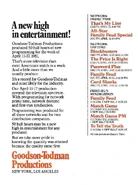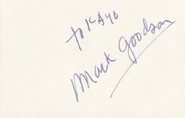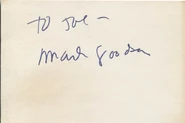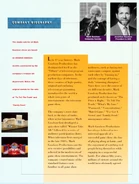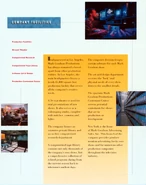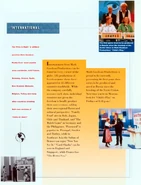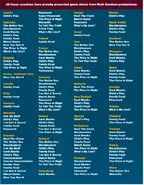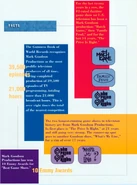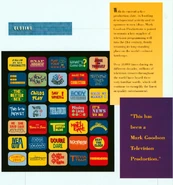Goodson-Todman Productions was a television production company formed in May 1946 by Mark Goodson and his longtime partner Bill Todman. Together they produced and created some of the longest-running and most successful game shows in television history.
History[]
In 1941, while working on the local quiz show, "The Battle of the Boroughs", Goodson met Bill Todman, a radio writer, director, and advertising copywriter. "I was impressed that he was rich enough to live on Park Avenue and own a Buick," Goodson says. The two found a mutual love for games and decided to partner. "Mark had an idea for a show called Winner Takes All" Todman said. "I changed it to Winner Take All. We auditioned the show for $15 including breakfast at Longchamps. And we went our way. In 1946 I called Mark. 'I got a sale,' I told him. Winner Take All was on for three 15-minute periods a week and $150." The pair's first quiz show, 'Winner Take All', premiered on CBS radio in 1946. They would go on to create four local radio quizzes: Hit the Jackpot, Spin to Win, Rate Your Mate, and Time's a Wastin'.
Winner Take All used a lockout buzzer system and was the first quiz show to pit two contestants against each other. It was also the first to have winners return each week until they were defeated, these firsts would later become the normal for nearly all game shows. Winner Take All also became the first Goodson-Todman television show, debuting on Thursday, July 8, 1948 on the CBS Television Network. What's My Line? soon followed on the same network, debuting on February 1, 1950. "Live television was like flying without a net," said Goodson. "We never knew what would happen. I remember Eddie Fisher as a mystery guest saying, 'Any rumors you hear that Elizabeth and I are breaking up are lies.' Another mystery guest, Judy Garland, had the show's staff chewing its nails when she wobbled in just before she was supposed to go on, with her hair in a riot of curlers, and promptly repaired to her dressing room. I was about to take her place," he contiunes, "when she came over to me and asked, 'How much time do we have?' I said, 'Fifteen seconds, Miss Garland,' and she replied, 'So what's the rush?' and walked onstage."
Quiz shows had been popular on radio through the 1940's, and they were just as popular with TV executives, thanks to costing little to produce and merchandise prizes were furnished for free by manufacturers in return for plugs. A well-known and oft-repeated story had Goodson and Todman carrying prizes for Winner Take All from their office to the studio, when Todman slipped sending small appliances clattering to the sidewalk. Writer Goodman Ace witnessed the accident and yelled, "Hey, Todman, you dropped your script!"
After "What's My Line?" Goodson-Todman began to turn-out game shows just like a factory line. Classic favorite Beat the Clock (1950-61), was followed with By Popular Demand (1950), It's News to Me (1951-54), The Name's the Same (1951-55), I've Got a Secret (1952-67), Two for the Money (1952-57), Judge for Yourself (1953-54), Whats Going On? (1954), Make the Connection (1955), Choose Up Sides (1956), To Tell the Truth (1956-68), The Price Is Right (1956-65), Play Your Hunch (1959-63), and Split Personality (1959-60). Three unsold pilots were also produced including, Rate Your Mate (1951), Take Your Choice (1954), and Play For Keeps (1955). By 1958, Goodson and Todman had become the most successful packagers in television and would become the most prolific game show producers of the 1950s.
Goodson and Todman would go on to produce some of the longest-running game shows in US Television history. While Todman oversaw the company's business outside of television, which included several New England newspapers and radio station KOL in Seattle, Washington, Goodson handled the creative aspects of producing game shows. The people who worked for the company and created many of Goodson-Todman's shows were pivotal to the success of those shows. Goodson-Todman executives like Bob Stewart, Bob Bach, Gil Fates, Ira Skutch, Frank Wayne, Chester Feldman, Paul Alter, Howard Felsher, Ted Cooper and Jay Wolpert, among others, were instrumental in making the shows successful.
Goodson and Todman also produced other fields of television programs, including anthologies, The Web (1950-54), The Richard Boone Show(1963-64) and Goodyear Theater (1957–1960); westerns, Jefferson Drum (1958-59), The Rebel (1959-61) and Branded(1965-67); crime drama, Philip Marlowe (1959-60); and possibly the company's biggest failure, One Happy Family (1961), a sitcom. “They wanted to expand their horizons; nobody wants to be pigeonholed,” says Andrew J. Fenady, who produced the westerns with them. Todman was an avid rider and a western fan, and where the shows were concerned, “You could talk to him any time,” Fenady says “He was there if we needed something. And the Goodson-Todman accounting was impeccable. We never went over budget, and we made a lot of money from their honest bookkeeping. They were very, very fair-minded partners.”
The 1960s saw the continued success of Goodson-Todman. Brand new shows premiered like Number Please (1961), Password (1961-67), Say When!! (1961–1965), Missing Links (1963–1964), Get the Message (1964), Call My Bluff (1965), Snap Judgment (1967–1969), He Said, She Said (1969–1970), and The Match Game (1962–1969). Other Goodson-Todman classics came to end, but three of the classics, What's My Line? (1968–1975), Beat the Clock (1969–1974), and To Tell the Truth (1969–1978), were revived in the same decade and all three saw huge ratings. An unsold pilot, It Had to Be You (1963), was also produced.
For many years the company was headquartered in New York City, New York at the Seagram Building located at 375 Park Avenue. Most of the company's production moved to Hollywood in the early 1970's, starting with the 1971 ABC revival of Password. The Los Angeles offices were located first at 6430 Sunset Boulevard, and later at 5750 Wilshire Boulevard. The company's last New York-based show was the 1980's version of To Tell the Truth, but the New York office remained open and was used for East Coast auditions for Child's Play.
The 1970s saw even larger success for Goodson-Todman. New shows included Now You See It (1974–1975), Tattletales (1974–1978), Showoffs (1975), Double Dare (1976–1977), Family Feud (1976–1985), The Better Sex (1977–1978), Card Sharks (1978–1981), Password Plus (1979-82), and Mindreaders (1979–1980). Revivals of Password (1971–1975), I've Got a Secret (1972–1973 and 1976), The Price Is Right (1972–present), Match Game (1973–1982), Beat the Clock (1979–1980), and the Barry-Enright game show Concentration (1973–1978). By early 1978 Goodson-Todman was producing 10 shows on 3 different networks. Two unsold pilots were also produced including, It's Predictable (1970) and Spellbinders (1978).
Mark Goodson Productions[]
The Goodson-Todman partnership continued until Todman's death in 1979, after which Goodson acquired the Todman heirs' share of the company, and in 1982 the company was renamed Mark Goodson Productions.
The 1980s and 1990s saw a slow down in production and success for the first time since the company was started. New shows included Blockbusters (1980–1982 and 1987), Child's Play (1982–1983), Match Game-Hollywood Squares Hour (1983–1984), Body Language (1984–1986), Super Password (1984-1989) and Trivia Trap (1984–1985). There was also revivals of To Tell the Truth (1980–1981), Tattletales (1982–1984), Card Sharks (1986–1989), Classic Concentration (1987–1991), Family Feud (1988–1995), Now You See It (1989), Match Game (1990–1991) and To Tell the Truth (1990–1991). A large number of unsold pilots were also produced, including Puzzlers (1980), Star Words (1983), Concentration (1985), Now You See It (1985), On a Roll (1986), Oddball (1986), TKO (1989), Body Talk (1990), Family Feud Challenge (1992), Match Game 2/MG2 (1996) and Card Sharks (1996). TKO is credited as the last original non-revival idea to come from the most prolific game show producer in television history.
Goodson died of pancreatic cancer on Friday, December 18, 1992 in New York City. Three years after his death, to pay off a massive inheritance tax, Goodson's family sold the rights to the library of his shows to All-American Television, which was subsequently taken over by Pearson Communications, and in turn, was acquired by FremantleMedia, now in turn, was acquired by Fremantle which now owns the rights to the library from Mark Goodson (& Bill Todman) Productions. The Mark Goodson Production logo continued to be used on many of his shows until Bob Barker's final episode of The Price is Right in 2007. Jonathan Goodson, who ran the company from 1992 until 1995, briefly used the "Mark Goodson Production" name and logo on three of his shows (Illinois Instant Riches, Bonus Bonanza, and Flamingo Fortune), before forming his own production company.
Employees[]
Timeline[]
Main Article:Goodson-Todman Productions/Timeline
Photos[]
See Also:Goodson-Todman Productions/Logo








